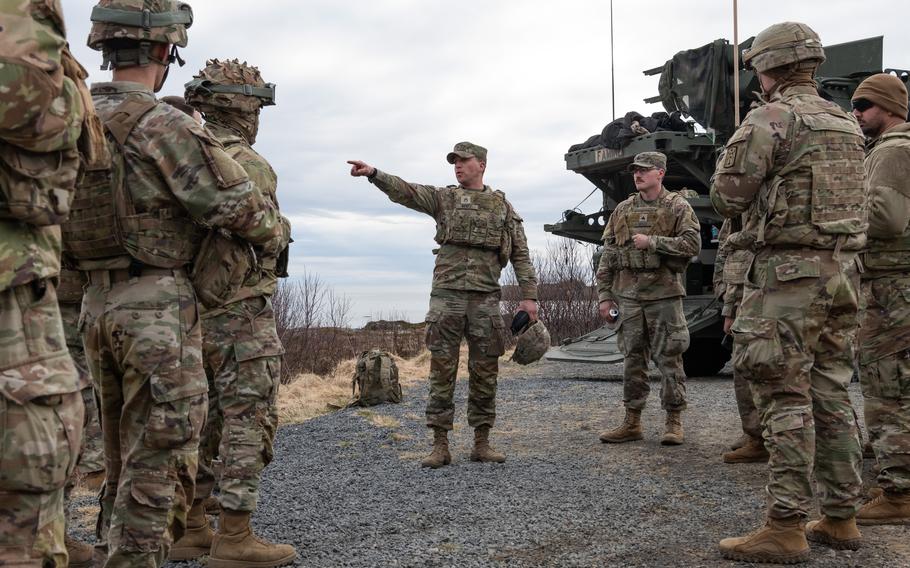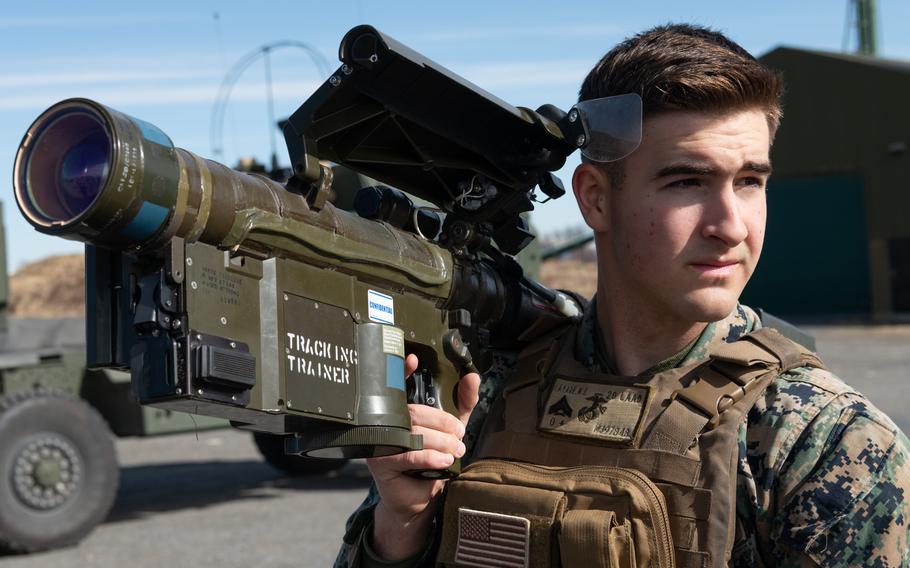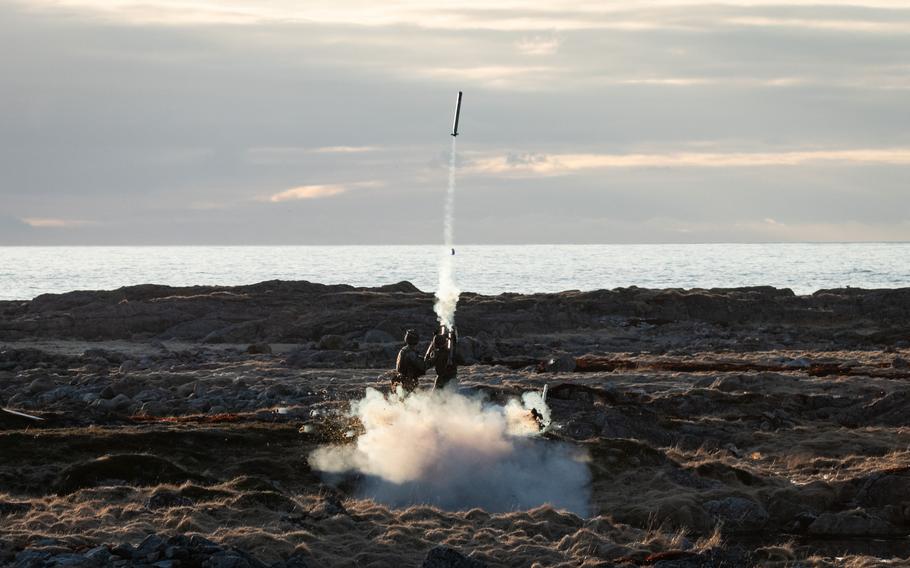
Staff Sgt. Elijah Bentz, master gunner for Alpha Battery, 5th Battalion, 4th Air Defense Artillery Regiment, speaks to troops in Andoya, Norway, on May 8, 2025, ahead of a live-fire drill that was part of NATO's Formidable Shield exercise. (Phillip Walter Wellman/Stars and Stripes)
ANDOYA, Norway — It was nearly 1:30 a.m., the Arctic sky was still light and Spc. Isiah Hernandez was wide awake.
“I have an adrenaline rush because I pulled the trigger,” Hernandez said, after firing a Stinger missile from the Army’s newest short-range air defense system.
The Friday morning launch marked the first time a U.S.-made Sgt. Stout — formerly known as the Maneuver Short-Range Air Defense system — fired a missile during an exercise with NATO allies.
That the first launch occurred during a Navy-led exercise underscores the belief among U.S. and allied planners that defending against potential Russian missile and drone onslaughts would require more coordination on land, sea and air, as well as cyberspace and in orbit.
The nearly monthlong Formidable Shield 2025 exercise began May 3 in northern Norway and will shift to Scotland’s Hebrides islands this week.
What began a decade ago as a naval missile defense demonstration has grown to include allied air forces and, in recent years, ground troops.
This year’s exercise features 16 ships, 27 planes and eight ground units from 11 NATO and partner nations, Navy organizers said.
The inclusion of ground-based, short-range air defense units — which target low-altitude threats like drones, helicopters and cruise missiles — comes as planners learn lessons from battlefield trends in Ukraine.
Last week, ground troops on Norway’s Andoya island acted as a final layer of defense, engaging targets that slipped past naval units in the Norwegian Sea.
The soldiers of Alpha Battery, a unit of the Army’s 5th Battalion, 4th Air Defense Artillery Regiment, based in Ansbach, Germany, were among them.
“You can imagine this is how a real-world scenario would be,” said Hernandez, one of the battery’s gunners.
In 2021, 5th Battalion was the first Army unit to field the Sgt. Stout. The system mounts Stinger missiles, a 30mm cannon and radar on an armored Stryker vehicle. Until this exercise, none of the battery’s soldiers had fired a live missile from it.
Hernandez’s shot narrowly missed. Other launches faced problems: one missile misfired, another plunged into the sea and a third crew couldn’t lock onto a target’s heat signature.
Staff Sgt. Elijah Bentz, the battery’s master gunner, said the issues could have stemmed from the age of the Stingers, some of which were more than three decades old. Part of the reason, he said, was that newer missiles have been sent to Ukraine.
Still, Bentz and other soldiers generally were happy with the unit’s performance in Norway.
“From what I observed, the crews shouldn’t have to change anything,” Bentz said. “Their engagement procedures were 100% good to go. I think now it’s just time to give feedback to the developers.”
The failure of one Sgt. Stout to lock onto a target during the final firing window gave its crew the chance to dismount and fire from the shoulder with a Man-Portable Air Defense System, or MANPADS.
After the shot, a group of soldiers filming with their phones erupted in cheers.
“Even with the little setbacks, that really boosted morale,” Bentz said.
In combat, other allied systems could backstop a failed intercept.

Marine Cpl. Marc Larade holds a Man-Portable Air Defense System in Andenes, Norway, May 8, 2025. Marines with the MANPADS were among the ground-based air defense units that participated in Formidable Shield 2025. (Phillip Walter Wellman/Stars and Stripes)
U.S. Marines also were among the forces that took part in the land-based portion of Norway drills.
Some assigned to Marine Air Control Group 28 also fired the MANPADS. Others ran a tactical air operations center, which directed U.S. and Norwegian ground-based units.
The inclusion of the Sgt. Stout and comparable Norwegian systems in this year’s Formidable Shield came after the Association of the U.S. Army in 2020 identified inadequate mobile short-range capability as one of the biggest gaps in the military’s air and missile defense. Their participation this year shows progress, officials said.
Another area of focus was on sharing the same tactical picture with the various countries involved.
Formidable Shield participants used Link 16, a network that collected data from ships, planes and ground-based radar.
“Our radar here can only see so far, but we push what we see to the network, and the ships that maybe can’t see over here get early warning,” said Maj. Ben Bowman, operations officer for 5th Battalion, 4th Air Defense Artillery Regiment. “Likewise, they can see a track further out than we can, so we have a heads-up that something’s coming a lot earlier and that just gives us the edge.”
Col. Hailey Bairu, commander of the Army’s 52nd Air Defense Artillery Brigade, emphasized the importance of a shared picture while visiting U.S. soldiers participating in the exercise, which he said was unlike any other in his 22 years in air defense due to its scope and scale.
“If we’re interoperable when a war kicks off, we’re going to be way ahead of any enemy that threatens peace,” Bairu said.
The 52nd Brigade, activated in 2022 in Sembach, Germany, was created to provide a permanent Army air defense headquarters in Europe.
In a February policy update, NATO noted that Moscow is “developing, fielding and employing numerous advanced air and missile capabilities.”
Cmdr. Senior Grade Fridtjof Joys of the Royal Norwegian Navy confirmed a Russian ship was observing the air defense drills from international waters. That, he said, is expected.
Speaking from a military base in Andenes, on the northern tip of Andoya, Joys added that allies were sending Moscow the right message.
Belgium, Canada, Denmark, France, Italy, the Netherlands, Norway, Spain, the U.K. and the U.S. are taking part in the exercise. Australia is contributing radar support for data collection.
“When they see a different ship each night with different drones, different air forces or (ground-based air defense) defending or attacking, it makes it complex for them,” Joys said, referring to the Russians.
Meanwhile, the ground troops were happy to be making the jump from firing weapons in simulators to the real thing.
Spc. Payne Radford was the commander of the Sgt. Stout that fired the first Stinger on Friday morning.
When asked if the battery was ready to defend against a possible enemy attack, he replied: “We’re more ready than we were yesterday.”

Marines assigned to Marine Air Control Group 28 fire a Stinger missile with a Man-Portable Air Defense System in Andoya, Norway, on May 7, 2025, as part of Formidable Shield 2025. (Phillip Walter Wellman/Stars and Stripes)